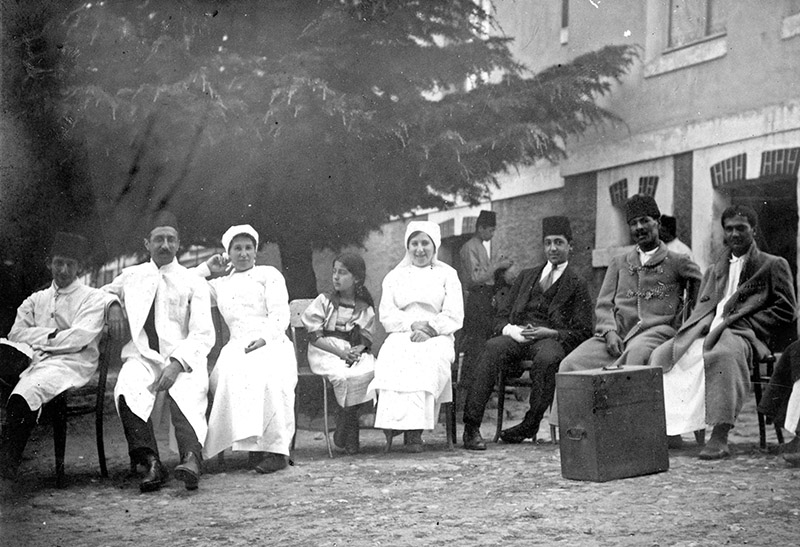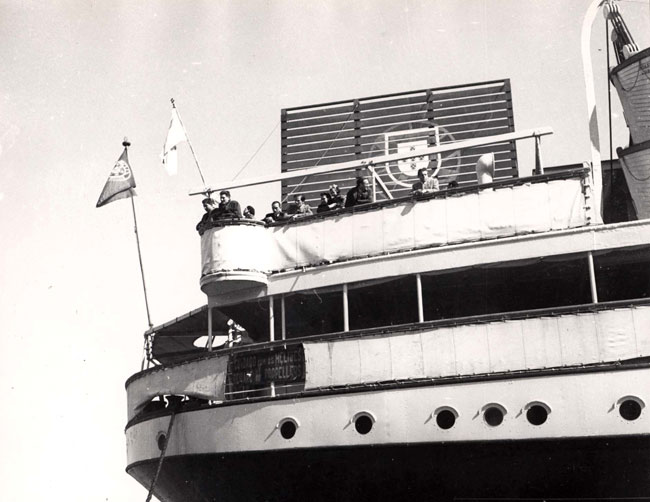Ronya Datnowsky
Name and spelling variations: Ronia, Ronja, Rebeca, Rebecca, Rivka
Ronya (Rebecca) Datnowsky, my grand-mother, is remembered by all who knew her as someone with a strong and unique personality. Born in Latvia, she found a husband in Constantinople, moved to Düsseldorf in the 1920s, then to Paris in the 30s, was a refugee in Spain during WW2, lived in Jerusalem, then moved back to Paris. She died in 1968.
Libau
Ronya Datnowsky was born on April 29, 1891 in Liepaja (Libau), the daughter of Abraham Datnowsky and Bassia Rabinovitz. Their second child, she had three siblings: Bertha, Liska, and Israel. She was named Rebekka, or Revveka, at birth, but went by Ronja, at least starting in 1909. By 1922, her certificate of nationality from the Spanish Consulate was established under her chosen name, Ronya. The spelling of her name varied over time: Ronja became Ronya, then Ronia in France in the 1960s.
As with other members of the family, there are a few variations for her date of birth. It was recorded as April 17, 1891 by the Riga Rabbinate according to the Julian calendar then in use, equivalent to April 29 in the Gregorian (Western) calendar. Since acquiring the Spanish citizenship in the early 1920's, Ronya however listed her date of birth as May 5, 1891 on all official documents, and would use this for the rest of her life.
| The Riga Rabbinate Vital Records - Libau, 1891 | ||||||||||
|---|---|---|---|---|---|---|---|---|---|---|
| Record Nº Female | Place | Year reg | Date of birth | Surname | Given name | Father's given name | Occupation of the father | Mother's surname | Mother's given name | Father's place of registration |
| 41 | Libava | 1891 | 17/04/1891 | DATNOVSKI | Revveka | Abram | Commissioner | RABINOVICH | Basha | Libava |
(Source: The Riga Rabbinate Vital Records - Births in Libava/ Libau/ Liepaja in 1891.)
Latvia was at the time a province of the Russian Empire, thus Ronya was a Russian citizen. Having historically been under German rule, Latvia's culture continued to be under a strong German influence, which is why her hometown was known by its German name, Libau. (It would only become Liepaja after Latvia became independent in 1918.)
The family moved to Windau (now Ventspils), about 90 miles south of Liepaja when Ronja was a young child. The exact date is not known, but would have been was as early as 1898, based on the estimated date of a family portrait taken in a local studio.

Front row, from left to right: Eva (Liska), Bassja, Israel, Ronya.
Back row: Bertha
Windau, 1898

Ronya, 1898 ?
From 1904 to 1909 (age 13 to 18), Ronya attended the Girls' Gymnasium (high school) in Windau (Ventspils).

Ronya's Girls' Gymnasium report, July 3rd, 1909.
On the first page of her school report, "Rebecca Abramova Datnovskaya" was identified as a "daughter of the merchant class", and as being Jewish.
According to this school report, she had skipped the first year and started with the second year after having succesfully passed the second grade entrance test in 1903 with a perfect grade. She attended grade 2 to grade 6 and completed her studies in 1908 when she successfully passed her final exams. The overall report stated that she had demonstrated a "P-E-R-F-E-C-T" behavior.
The results of her final exams are as follow:
She had no grade for Bible study, presumably excused since she was Jewish.
Russian was her weakest topic, as she only received a 3 (out of 5).
She scored a perfect 5 in Math, 4 for History, Geography, and Russian History.
She received another perfect 5 for Physics.
Her overall average was 4.16, and the report concluded that she had achieved "great results".
In addition to these required topics, she also took several optional courses: German, for which received a "good" grade, and Art and Drawing, for which she received an "excellent" grade. She wasn't graded in French, another optional course, indicating that she either didn't study French, or if she did, only for a few years. She would of course learn French at some point as she would eventually resettle in Paris in the early 1930s.
While primary school was mandatory in Latvia, secondary school was not, and was not free, suggesting that the family had the means to afford it, while at the same time paying for their eldest daughter to attend university in Bern. (Confusingly, however, Ronya's youngest brother Isrolke started to attend the agricultural school in Ahlem in August 1906, a vocational school for children of needy families.)

Ronya and classmates, Russian School, Latvia, 1909
All the young ladies wear their hair in a bun, the teachers are in uniforms, and an Orthodox priest seems to be in charge.

Group of students: Immerman, Jacobsohn, Jacobi, Goldsctück, Israelsohn, Feitleberg, Gerson, Jacobi, Savrunova (?), Datnowsky, Richter. Windau, Latvia, 1909.
Ronya is sitting in the front row, 2nd from the right with her hand clasped.
Although the school seemed to be a Christian school, due to the presence of an Orthodox priest, most of the girls on this photo had Jewish names. (Except for Savrunova, all of these surnames appear on a list of victims of the Shoah from Libau: http://www.liepajajews.org/wc_idx/sur.htm.)
Ronya's presence in what appears to be a Christian school suggests that her parents were already sufficiently assimilated, and valued secular education above strict adherence to tradition. The fact that she was surrounded by so many other Jewish girls suggests that this was not exceptional at the time, and that she belonged to what must have been an "enlightened" Jewish middle class.

Ronya, 1909


Card from Dr. Israel Auerbach, addressed to Ronya in Windau.
Dr. Israel Auerbach, the husband of Ronya's elder sister Bertha, wrote to her while she was attending school in Windau. Although the postcard has no date, it must have been sent after August 1906 when her brother, Israel ("Srolke"), had already joined the agricultural school in Ahlem. He had previously been registered in Charlottenburg, where the Auerbachs lived.
Dear Ronja,
It's been ages since I wrote to you, hasn't it? I ask you not to be angry with me for this, I will certainly improve. I hope you are doing well.
How are you coping now without your brother? I became very close friends with Srolke when he was here.
I send my sincere regards to your esteemed parents.
Dr. Israel Auerbach

Ronya in Windau, Latvia, 1909
Constantinople, 1909-1912
In 1909, Ronya's mother Bassja died. Along with her two younger siblings Eva (Bitia) and Israel (Isrolke), she came to Constantinople where her elder sister Bertha and her husband Dr. Israel Auerbach had been living since 1908.
Ronya had finished high school in the spring of 1909. On July 15, she was issued a passport to travel abroad in Libau, and after a stop in Odessa on August 1, 1909, she arrived in Constantinople. She was nineteen.
(* According to Bertha's 1938 registration with the German consulate in Jerusalem, her mother had died in 1910; However, her tombstone, although hard to read, seems to indicate 1909. The date on Rachel Auerbach's postcard shows that she lived in Constantinople in the summer of 1909, and according to family lore, she went there following her mother's death.)

Telegram sent by Ronya to her sister from Odessa announcing her arrival in Constantinople, August 19, 1909.
In Constantinople, Ronya lived with her sister Bertha and Israel Auerbach, in the Galata neighborhood. It's not clear if she remained in Constantinople between 1909 and her marriage in 1912, or alternated with Berlin, but until her marriage, her address in Constantinople was at the Auerbach home.
Three postcards, dating 1909, 1910 and 1910 are addressed to Ronya, c/o Dr Israel Auerbach.

Postcard from Rahel Auerbach, 1909

Ronya (3rd from left), with Bertha, Eva and Israel in Constantinople - 1909
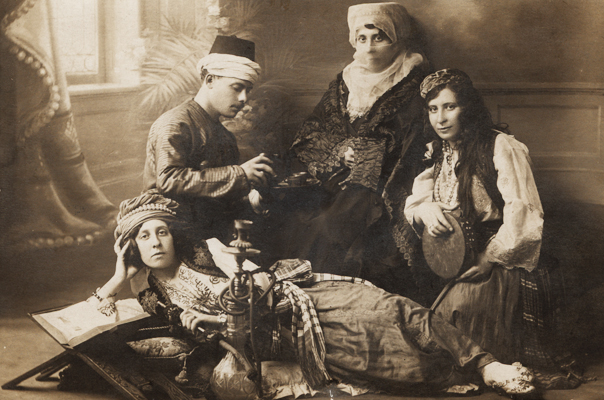
Ronya (with veil), with Bertha, Eva and Israel in Constantinople - 1910

Ronya, Constantinople, 1909 or 1910

Ronya, Cospoli Eyoub, 1910 (Cemetery of Eyoub)
Ronya Datnowsky - Travel to Palestine, 1910
In the summer of 1910, less than one year after arriving in Constantinople, Ronya received a "tezkere" (travel permit) for Palestine.
What were the reasons for this trip? How long did she stay? And who did she travel with?
There is no information at all regarding this trip except for a few photos and this travel document.

Travel document from Constantinople for Haifa - 1910
This travel permit was issued by the Russian Consulate in Istanbul in July 1910 . It authorizes "Mademoiselle Datnovski" to travel to Haifa.
Age: 19
Height: medium
Eye color: hazel
Nationality: Russian
Religion: Jewish
Occupation: not legible.
Although the tezkere was made in her name and was made out for "one traveller", it is difficult to imagine that a nineteen-year-old woman would travel on her own from Constantinople to Palestine in 1910, and so I assume that she didn't travel alone but had a companion. There are however no clues as to who her travel companion(s) could have been.
She probably hadn't met her future husband yet, and even if she had, she probably would not have travelled with a man she hadn't married yet.
Although there are no documents to confirm it, it is possible that she travelled with her brother Israel (Isrolke) - maybe to see him on his way to Palestine. (The exact date of Israel's arrival in Palestine is not known, but he lived there since at least Febrary 1912.)
Ronya also had several friends in Palestine at the time - as evidenced by a number of postcards from that period. Although this doesn't provide a reason for the trip, it suggests at least that she wasn't completely on her own.
It's also possible that she could have travelled with Israel Auerbach, who made frequent trips to Palestine around that time, or that her travel was connected somehow to Elias Auerbach, who resided in Haifa. The brother of Israel Auerbach, he was a physician and had opened the first Jewish hospital in Haifa.
Jerusalem
This group photo taken in Jerusalem doesn't show any other familiar faces which might help understand the reason or nature of this trip, although the man with the moustache sitting *might* be her brother Israel.

Ronya, with jug, Jerusalem, 1910-1911. Photo: M. Swides & J.Hotinsky.
The man sitting may be Ronya's brother Israel Datnowksy. The woman sitting on the floor is Ms. Weinberg, a friend of Ronya's.
This photo is typical of early 20th century studio portraiture, the painted background and costumes providing what was meant to be an "authentic" "Oriental" look.
Zichron Yaakov
Surprisingly, there are a few photos of Ronya on a horse, next to Aaron and Sara Aaronsohn in front of their house in Zichron Yaakov. Why was Ronya visiting Zichron? How did she know the Aaronsohns? Maybe the person who took the photos was her fellow traveller, but we'll never know...
A possible answer is that she was introduced either by Israel or Elias Auerbach who knew the Aaronsohn family.
Four years later, Haim Abraham, the oldest brother of her future husband Moritz, would marry Sara Aaronsohn. Coincidence? Or did the Abraham brothers have contacts with the Aaronsohns earlier than 1913, when friends supposedly mentioned Haim as a prospect for Sara?

Zichron Yaakov, 1910: Ronya, Sara and Aaron Aaronsohn.

Zichron Yaakov, 1910: Ronya, Aaron and Sara Aaronsohn.
There is no information on what Ronya did after this trip, whether she stayed in Constantinople with her sister Bertha, or instead went to Berlin.
Marriage
It is probably around that time that she was introduced by her sister to Moritz Abraham, a wealthy merchant from Ruschuk, Bulgaria.
In December 1911, Ronya and Moritz Abraham got engaged.

Engagement announcement
Her father sent this three-word telegram:

Telegram from Abraham Datnowsky to Ronya, December 1911
"Be Blessed. Datnowsky". December 5, 1911.
Their engagement was announced in the December 22 issue of Die Welt, the central organ of the Zionist movement.
It was also mentioned in the December 22 issue of L'Aurore, the Constantinople Jewish weekly.

L'Aurore, Constantinople, December 22, 1911
In April 1912, the Russian Consulate in Constantinople issued a certificate in French affirming that - based on the "credible testimonies of two Russian citizens" - Ronya Datnowsky was not married.

Certificate from the Russian Consulate, July 1912
Ronya married Moritz Abraham five months after their engagmeent on May 19, 1912 in Constantinople.

Ronya and Moritz, wedding, Constantinople. "Souvenir of May 19th, 1912"

Wedding announcement in French. 1912
Their marriage was announced in the May 31, 1912 issue of Die Welt.

Telegram from Abraham Datnowsky, May 19th, 1912
"Wishing Happiness Blessings. Father."
Abraham Datnowsky's telegram was addressed to Auerbach because Ronya lived with her sister Bertha and her husband Israel Auerbach until her marriage to Moritz.
1912: Berlin. Business travel with Moritz? honeymoon? or vacation? No precise date, so this could be before or after their wedding.

Ronya and Moritz. Berlin, 1912
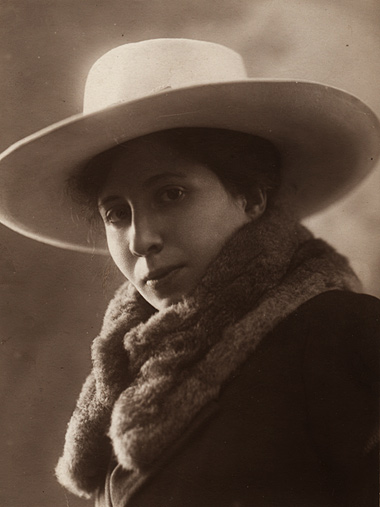
Ronya, Constantinople

Ronya, Constantinople

Ronya, Constantinople
Balkan War - 1912 - 1913
In October 1912, the first Balkan War started: an alliance made up of Bulgaria, Greece, Serbia, and Montenegro, under Russian auspices, attacked the Ottoman Empire. Within a few weeks, Turkey had been pushed back to maintaining the defense of Constantinople.
The war brought a large number of wounded to Istanbul, and soon a cholera epidemic broke out, resulting in significant healthcare needs. Most of the governmental and official buildings in Istanbul were turned into hospitals, and the ladies of Istanbul nobility participated voluntarily in the provision of healthcare services.
On November 1st, 1912, Ronya finished a three-week nurse course at the German Hospital - which means she had enrolled in the class at the very beginning of the hostilities. Ronya had been married for less than six months when she became a volunteer war nurse with the Red Crescent.

Nurse class certificate, 1912
Constantinople, November 1, 1912
German Welfare Association
German Hospital
Mrs. Abram
Participated in a three-week course for voluntary wartime nursing at the German Hospital in October 1912 and is qualified to practice nursing
Since Bulgaria was attacking Turkey, with the support of Russia, and Ronya was a Russian subject married to a Bulgarian Jew, it may seem strange that she got involved on the Ottoman Empire's side. However, it seems from the photos below that her case was not so unique: all the nurses seemed to be foreign. According to my father Uriel, "it was the thing to do for well-to-do young ladies at the time...". Maybe it was a way for foreign Jewish residents to prove whose side they were on, especially as Turkey was losing to the enemy.
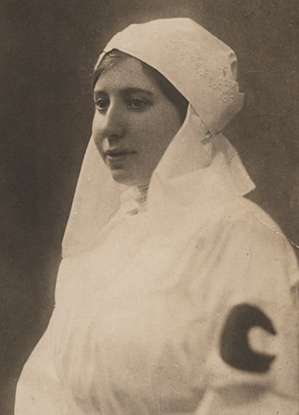
Ronya in nurse uniform - 1912

Ronya, Balkan War - Constantinople, 1912

Ronya, Balkan War - Constantinople, 1912

Ronya, Balkan War. Constantinople, 1912.
Legend: Kemal Bey, Fraulein Morvien, Fraulein Abramovitz, Saud Bey, Ronya Abraham, ?, Frau Ludner, Mehmed Ahmed, Ali ?, Hussein ? .
Interestingly, the nurses all have German and/or Jewish names. Fraulein Abramovitz may have been the wife of Moritz Abramovitch (no relation to Moritz Abraham), chairman of Maccabi Constantinople until 1908.
In the January 1913 issue of "Die Welt", the Zionist Organisation publication, a brief article appeared under "Short News from Constantinople", mentioning Rornya's "heroic" service during the war:
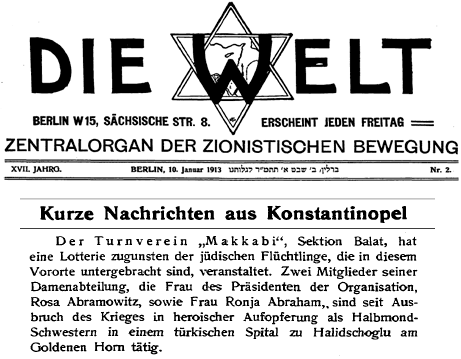
Die Welt, January 1913.
The gymnastics club "Maccabi", section Balat, has organized a lottery on behalf of Jewish refugees who are accommodated in the suburbs. Two members of the Women's Department, the wife of the President of the organization, Rosa Abramowitz, and Ms. Ronja Abraham, have since the outbreak of the war been active in heroic self-sacrifice as nurses of the Red Crescent (Crescent-sisters) in a Turkish hospital in Halidschoglu on the Golden Horn.
In the December 4, 1914 issue of l'Aurore, a French language Jewish weekly, a brief mention of Ronya ("Mme Moritz Abraham") for her participation as a nurse to the Balkan war.

L'Aurore, December 4, 1914
The first paragraph mentions three Jewish ("correligionnaires") ladies who received the Order of the Chefakat, third class (an order bestowed on women for distinguished humanitarian or charitable works): Mrs. Lily Gunzberg, Mrs. Lily Donsaft and Mrs. Marguerite Rosenthal. The second paragraph mentions "[...] other Jewish ladies who also distinguished themselves under the same circumstances, among them Mme Moritz Abramovitch and Mme Moritz Abraham (Ronya). We believe that their zeal and their patriotic zeal will be rewarded also". (Ronya would receive a "Berat" for her work as a nurse in 1916.)
WW1 - 1914-1915
On 28 October 1914, fifteen months after the end of the second Balkan War, Turkey entered World War I on the side of Germany and Austria, against France, England and Russia.
Soon after the outbreak of the war, Ronya again enrolled as a volunteer nurse in support of the Turkish war effort.

L'Aurore, 18 December 1914
List of Jewish ladies and young women who have registered for nursing and caregiving services.
Source: www.nli.org.il, via Cenker Sarıkaya.
In the list are a few familiar names: Rosa Abramovitz, presumably the wife of Moritz Abramovitz, chairman of Maccabi; Gentille Coenca, possibly a cousin of Moriz Abraham; Ziffer are most likely related to Abraham Ziffer, another head of the Maccabi.
It seems that her service as a nurse lasted only until 1915.

Ronya, nurse, WW1- 1914 or 1915
Wounded soldiers wave Turkish flags without much enthusiasm, and Ronya's neighbor is dutifully attaching a Red Crescent armband. A photo taken right before shows her without the armband.
See more photos related to Ronya's service as a nurse.
Recognition
In 1916, Ronya was awarded a bronze medal and received a berat with the Sultan's seal (tugra) in recognition of her services as a nurse during WW1.

Berat with the tugra of Sultan Mehmed Reshad (1916)
"Medals in different levels had been granted to the women whose services regarding the material and spiritual interests of the Ottoman Red Crescent Society were appreciated.
Madame Abraham, who served at Sisli Etfal Hospital as a nurse helping the patients with their treatment and recovery, deserves one as well.
Based on the special regulations, in accordance with the decision that had been made by the Red Crescent Society, a bronze medal of the same kind was granted to her and thus this imperial Berat has been issued for the grant of this bronze medal.
Written in the day 13 Sevval 1334 (August 13 1916)."
Tugra: The big drawing at the top is called a tugra (tughra) - it's the signature of the sultan. The tugra in this document belongs to the 35th Ottoman Sultan Mehmed Reshad (Mehmed V Reshad (2/3 November 1844 - 3/4 July 1918).
Berat: When Sultans granted something to people to show appreciation for their services, he issued a berat. Grant might be a medal, nomination to a higher rank or right to use of place or property. This document was issued for a bronze medal that your grandmother received as an appreciation for her services in the hospital.

Hospital thank-you note
This thank you note was written by the chief doctor of Sisli Etfal Hospital in Istanbul, and was sent to Ronya in 1915. The chief doctor thanks her for her great efforts in taking care of the injured soldiers, in the hardest time of WWI.
Constantinople 1916 - 1922
1916
In July 1916, Aaron Aaronsohn, the brother of Sarah Aaronsohn who had married Haim Abraham a year earlier, arrived in Constantinople. A world-famous agronomist and leader of the NILI spy ring, he paid a visit to Ronya.
He wrote in his diary:

Aaronsohn Diary - July 25,1916
Courtesy of Beit Aaronsohn
(...) I go pick up Ronya and Collen (?) at the Pera Hotel to go to Abramovitch where Dr. Caleb will give me injections against cholera.
Tuesday July 25, 1916
(...) "After 9 am, we go with Ronya to examine Sara's house. We have the keys to the house, but all the rooms are locked, and we need to use a locksmith who forces the doors. We find the house in a mess, and Mrs Blumberg is kind enough to take it upon herself to put things in order.
(...) From there at 1 pm I go to have lunch with Ronya in her apartment, which is well-lit and bright."
What is interesting is that Aaronsohn mentions Ronya and not her husband Moritz Abraham, who was after all Sarah's brother-in-law. This is probably a sign that Ronya maybe knew the Aaronsohn family first, or had a closer relationship with them. Any details however are lost, at least until the unpublished portions of Aaronsohn's diary become accessible and maybe provide more information.
A few days later, miles away in Palestine, Ronya's younger brother Israel Datnowsky died under confusing circumstances - the official story later repeated in the family was that he had died of an epidemic (most likely typhus). However the following entry in Aaron Aaronsohn provides a different version of the events, which may be closer to the truth, since it is a contemporary record:
August 15, 1916, Constantinople:
"Ronya received a telegram from the Jaffa Consulate announcing the death of Datnowsky Israel at Wilhelma, following an accident. This telegram which left Jaffa on the 1st, only arrived here on the 13th."
See Israel Datnowsky's page for the circumstances of Datnowsky's death.
1917

Comite des Dames du B'nai B'rith, 1917.
Ronya, standing, second from the left.
In Constantinople, Ronya's circle was apparently made up predominantly of Western European Jews.
In 1917, Ronya's and Moritz's first son, Gisy (Gedeon), was born
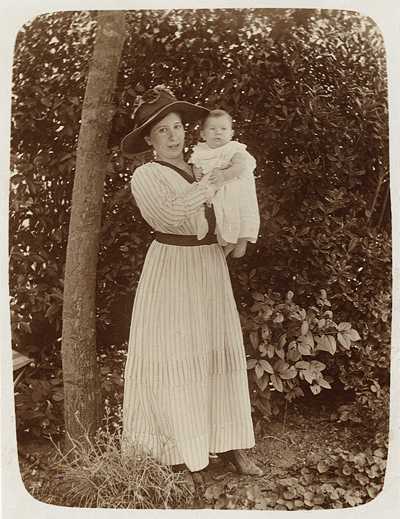
Ronya with first son Gisi, Constantinople, 1917
1918
1918: Ronya's and Moritz's second son, Uriel was born.

Ronya with Gisi and Uly, Constantinople, 1919
1920
In the Summer of 1920, Ronya, the children and their nurse Kitza travelled across Europe. According to the Travel Pass issued by the Italian Authorities in Constantinople, the trip was for "Health and Personal (?)" reasons.

Travel pass issued by the Italian Authorities in Constantinople, 1920.
We ask the Inter-Alliance Authorities, military and civil, to please facilitate travel for Mrs. Abraham and children, who for reasons of health and of interests (?) are traveling to Switzerland and Germany. The above mentioned lady and her children are carrying valid passports.
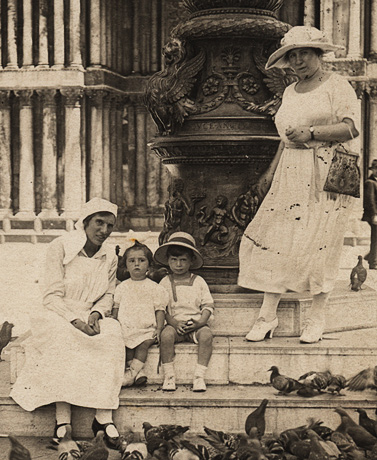
Kitza, Uly, Gisi and Ronya in Venice, 1920
Becoming Spanish
In November 1922, Ronya acquired the Spanish nationality, or at least received a document showing that she was under the protection of the Spanish Consulate. Her husband Moritz, a Sepharad, also acquired Spanish nationality around that time, and Ronya, formerly a Russian citizen, presumably acquired this protection (or citizenship) simply as a result of her marriage.

Certificate from the Spanish Consulate in Constantinople, 1922
Consulate of Spain in Constantinople
The Consul of Spain in Constantinople hereby certifies that Doña Ronya Abraham, May 5, 1891, born in Ruschouk 29 years old, married, housewife, is registered under number 283 in the Register of Administered Subjects kept by this Consulate.
Constantinople, November 2, 1922
Surprisingly, this certificate states that she was from Ruschuk. It is not clear whether this means she lied about her place of birth in order to come under the protection of Spain, and that this fable had been accepted by a lenient consular employee looking to faciliate the naturalisation of the family, or rather that she somehow "inherit" this place of origin simply by virtue of being married to a former resident of Ruschuk.
In addition to changing her place of birth from Libau (which had become Liepaja and part of Latvia since 1918), her age was also off by two year: born in 1891, she was 31 years old in 1922, not 29 as indicated in this document.
It is possible that she acquired this new status even earlier, but only proceeded to apply for this document ahead of the family's planned move to Germany that year.
Ronya and Moritz had no way of knowing it then, but their decision to acquire the Spanish nationality would provide them with some protection almost two decades later in German-occupied Paris. In particular, the Spanish nationality would allow Ronya to flee France and cross the border into Spain in 1943 after the death of her husband.
A Spanish Certificate of Nationality established in October 1923 a year later in Düsseldorf shows that, by then, Ronya had become a Spanish citizen.

Certificate of Nationality from the Spanish Consulate in Düsseldorf, October 1923
Here again, her place of origin is incorrectly indicated as Bulgaria.
The Consul of Spain in Düsseldorf certifies that in the Register of Spanish Nationals held at this Consulate, there is an entry marked No. 16 (year 1923), which reads:
Mrs. Ronya Abraham
Née Datnowski
Province of Bulgaria
married
Daughter of Abraham (Datnowski)
Residing in Düsseldorf, 20 Lindemann Street
accompanied by two children.
And in order that the interested party may prove his nationality and identity wherever appropriate, I issue this document in accordance with Articles 66 and 67 of the current Consular Tariff.
Düsseldorf, October 4, 1923
From Constantinople to Germany
According to family lore, Ronya, not wanting to live in "Oriental" Constantinople, convinced her husband Moritz to move the family to Germany.
It is likely that the political turmoil in Turkey following the fall of the Empire and the rise of the Young Turks contributed to the desire to leave Constantinople.
This is probably the last photo of Ronya and Moritz in Constantinople, taken in 1922

Ronya and Moritz, Constantinople, 1922
Düsseldorf
Moritz bought an empty lot on LindenmannStrasse in Düsseldorf, for which he commissioned an architect to build their house. Ronya, Uriel and Gisy first came to Düsseldorf in 1922, while Moritz stayed behind in Constantinople until December of that year, taking care of his business, and eventually dissolving his partnership with his brother Haim in an acrimonious dispute.
While the construction of the house went on, Ronya, Gisy, Uriel and their nurse Fraulein Ewald lived in Frau Brockerhoff's boarding house, a guest house popular with artists and intellectuals in Düsseldorf.

Ronya, Uly, Gisy with Mme Cornfeld, in front of the house, Düsseldorf, 1926
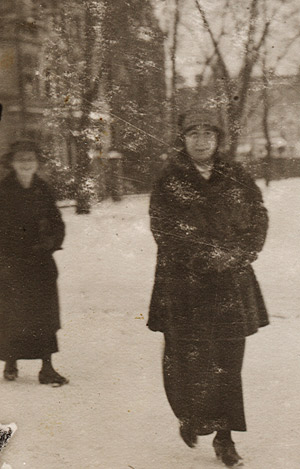
Ronya and Fraulein Ewald, the nanny - Düsseldorf, 1925
1927
Based on an inscription to my grandmother by Johanna Thal-Birsen in her book "Die wilde Katschke: Bilder aus dem Osten", it appears that Ronya may have attended the 15th Zionist Congress in Basel:

Die wilde Katschke: Bilder aus dem Osten, by Johanna Thal-Birsen.
If you take my book in your hand, think of our long gone youth in Libau and to the lovely Congress time in Basel.
In memory of Mrs. Abraham,
Johanna Thal-Birsen, Basel, 4 September 1927
Since the 15th Zionist Congress was held in Basel from August 30 to September 11, 1927, the date in the inscription (4 September 1927) and the location seem to indicate that Ronya was in Basel during the Congress. Although it's impossible to confirm that she attended the Congress, one can assume that her presence in Basel then was not a coincidence; Instead a likely explanation is that she came with her husband Moritz ("National Commissar of the Jewish National Fund" at least in 1922), and maybe also with his brother Haim - who was known to have attended several Zionist Congresses.
1928
In the late 1920s, Dora Diamant, Franz Kafka lover, befriended Ronya. Dora was studying theatre in Düsseldorf (at the Dumont Drama Academy according to wikipedia; at the "Schauspielhaus" theater according to my father's recollections).
A struggling actress, Ronya helped support her financially - my father described her as a "protégée of Ronya" - and she was hired as my father's private Hebrew tutor.
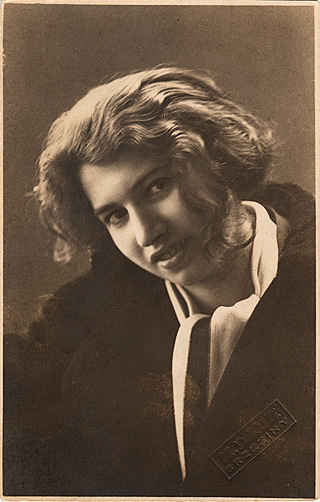
Dora Diamant, Düsseldorf, 1928
As a testimonial of her friendship, she gave Ronya her photograph and first editions of novels by Kafka: A Hunger Artist (1922), The Trial (1925), The Castle (1926), and the short story The Verdict (1916).

Kafka's The Castle, original 1926 edition, inscribed by Dora Diamant.
Zum Dank für die Fügung die uns zusammenbrachte.
Dora Diamant KafkaIn gratitude for the good fortune that brought us together.
Dora Diamant Kafka
1929

Ronya, Celerina, 1929
Berlin
Around 1929, following a reversal in the family's fortune, Ronya and the children temporarily moved to Berlin. There, they lived with her sister Bertha and her husband, Israel Auerbach.
A postcard dated May 22, 1930 addressed to :
Frau Ronja Abraham
bei Herrn Dr Auerbach
Berlin - Grunewald
Douglas Str 30
Why and when they came to Berlin is not known; I assume the family had to leave their Düsseldorf home, which may have been foreclosed by a bank, or else been rented out. A couple of photos of the Uriel and Gisi at the Goetheschule in Berlin are dated 1929 and 1930. In March 1930, Gisi had his Bar Mitzvah in the Synagogue Friedenstempel in Berlin.
Paris
In 1930, Ronya and the family left Berlin and moved to Paris. There, the family moved several times, but always remained in the 16th arrondissement. At first they lived 12 bis rue des Marronniers. In 1930 they lived 117 boulevard Exelmans, then moved 67 rue Erlanger. By 1933, the family moved again, this time to 122 boulevard Murat.
(In her "Carte Permanente de Travail" (Permanent work card) delivered in April 1948, the date of her entry in France was given as 1931.)

Ronya, balcony of 122 boulevard Murat, Paris, 1933.
1938
In the summer of 1938, Ronya travelled to Palestine, apparently without Moritz. She sailed the S.S. Champollion, making a short stop in Alexandria, and arrived in Haifa on August 22. She left one month later, on September 22, and disembarked in Marseilles on September 28.

S.S. Champollion
During her trip, she visited all her relatives: her sister Bertha and her family (Israel and Lea Auerbach, Israel's brother Elias), Eva, Ascher and Bitia, and Visa De Leon.
Was this just a vacation, an excuse to see the family? Or was she considering moving there as the war loomed?
Ronya's Spanish Passport bore a red stamp: "Not valid - including transits - for Germany, Italy, Portugal, Austria and Hungary"
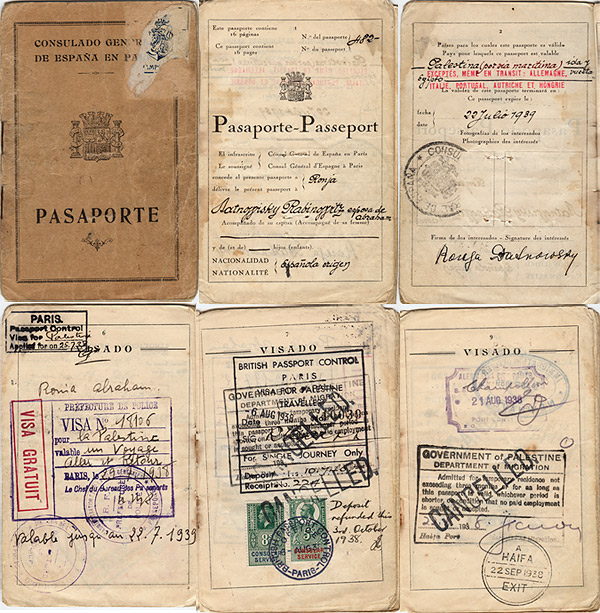
Ronya's passport - 1938
In April 1939, she took another short trip, this time to England, leaving from Dieppe to Newhaven on April 9, then returning to Dieppe two weeks later on April 16, 1939.
What was the purpose of her trip? Did she go there to see a relative? Or was she planning to move there in the event of a war? Germany had annexed Austria one month earlier.
In September 1939, the family moved once more, this time to 35, Rue de Lubeck, in the 16th arrondissement.
WWII
In May 1940, Germany invaded France, marking the end of the "Phoney War". On June 3, 1940, the Germans bombed Paris, and half of its population joined a mass exodus, fleeing the German advance. Among them was Ronya's son Uriel, who rode a bicycle all the way to the south of France, from where he would sail to Casablanca.
Ronya and her Moritz chose to stay in Paris. Although Nazi Germany's antisemitic policies were no secret, they probably could not imagine what lay ahead for Jews under Nazi rule. Moritz's age - he was 59 - may have also been a factor.
There is no information about how Ronya and Moritz experienced the early years of the German occupation. No oral histories or documents—whether letters or official papers—have survived to provide insight into their lives between 1940 and 1942.
Ronya and Moritz were Spanish citizens, and as such, were partially protected from anti-Jewish laws. They most likely did not wear the yellow star, as Spaniards weren't required to. However, Moritz's identity card bore the red 'Jew' stamp, and it is assumed that Ronya's did as well - although her ID card has not been preserved.
The protection they received was not the result of the Spanish government's official directives, but of the Spanish Consul in Paris, Bernardo Rolland. Rolland issued "letters of protections" to shield "Spanish" Jews - mostly Jews from the Balkans.
While the Spanish government resisted calls to protect Spanish Jews or grant them visas, it was primarily concerned with preventing the expropriation of their assets by the Germans — assets the Spanish government believed should fall under its own control.
Bernardo Rolland, defying the directives of his superiors, went above and beyond the call of duty and is believed to have helped save the lives of more than 300 Jews of Spanish nationality, including Ronya and Moritz.
Beginning on October 1, 1941, by order of the Police Prefecture, all Jews, both French and foreign, had to report to the authorities. This reporting was to be periodic, so that the authorities would be aware of their situation and activities at all times. Although the Police archives were destroyed after the war, it is assumed that Ronya and Moritz complied.
In 1942, the situation of Jews in France further deteriorated, with new anti-Jewish laws targeting foreign Jews, including in December the stamping of ID cards with "Jew".
In January 1943, Bernardo Rolland sent the following certificate to Ronya:

Certificate from Bernardo Rolland, Spanish Consul in Paris. 18 January 1943
The Spanish General Consul in France certifies that:
Mrs. ABRAHAM, née Rouya [sic] DATNOWSKY, Sepharad, holds Spanish nationality and, as such, benefits from the provisions of the Franco-Spanish Conventions regarding the treatment of Spanish citizens in France.
Paris, January 18, 1943.
The General Consul.
Bernardo ROLLAND
Two weeks later, on January 31st, 1943, Moritz died.
In March 1943, Moritz's certificate of nationality was cancelled by the Spanish consulate in Paris.
At the end of the month, on March 29th, Ronya received a new passport from the Spanish Consulate in Paris.

Ronya's Spanish passport, March 29, 1943.
Although it was now stamped "CANCELLED", Ronya still held on to Moritz' official document, which was most likely crucial in proving that she deserved the protection from the Spanish authorities.
Three weeks later, she left Paris and found refuge in Spain.
Why did Ronya finally decide to leave Paris? Did she fear that with the death of Moritz, her Spanish citizenship would be questioned and would not protect her anymore? While Moritz was a Sepharad, she was a Russian Jew from Latvia - her claim to Spanish protection was clearly more tenuous.
According to Michael Rosenberg, who claimed to have heard Ronya describe her flight to his grandparents in Jerusalem in the 1940s:
"One day there was an 'Aktion' against the Jews in Paris and she had gone to someone's funeral (not her husband's, because he had been dead for 'many years' [sic]), someone there tipped her off that the Germans were waiting for her in her apartment. She didn't go home, and instead went directly to take a train to Madrid. All she had with her was her purse, but it contained her husbands' 'Consul honoraire d'Espagne' [sic] passport which she always carried with her to protect her. Because she carried such document, they had to let her through the border. The passport was not even of Franco's Spain, but of the Monarchy."
Although the exact circumstances of her departure from Paris may never been known, the reality was somewhat less cinematic. Her passport contains a visa issued by the Spanish Consul General in Paris, Bernardo Rolland, on April 13, for entry between April 18 and 24, 1943.

Consul Genearl Bernardo Rolland's visa. April 13, 1943.
Spain - 1943
Ronya crossed the border in Hendaye on April 19, 1943.
According to my sister, the border guard had refused to believe that she was actually a Spaniard, because she didn't speak Spanish and, of course, because of her Russian-sounding name and heavy Slavic accent. According to her, at some point, the guard turned his head and wasn't looking, so Ronya "simply walked on and crossed the border."
This account is likely apocryphal. While there is no doubt that the German border guards must have been dubious as to the authenticity of her passport, and probably hesitated to let her cross the border, they apparently had to give in since she was in possession of a passport with a valid visa and possibly Moritz' papers as well. Most likely, the German border officer simply "looked the other way" and decided not to stop her.

Ronya's 1943 passport with exit and entry visas. April 19, 1943.
Her passport contains both an exit stamp from the German border guards in the Hendaye station ("Zollgrenzschutz - Übergangsstelle - Hendaye-Bahnhof"), and the entry stamp, clearly demonstrating that she crossed the border legally.
She first lived in Barcelona, and stayed in the Neutral hotel, 42 Rambla Cataluña.

Letter addressed to "Madame Ronia", Pension Neutral, August 1943.
Why she kept this letter, bringing it with her to Palestine, then back to France, is not known, as only the envelope remains today. (The letter was sent by a Mrs. Ralurer (?), with a return address in Brioude, Haute Loire; formerly in the non-occupied zone, it was occupied by the Germans since November 1942. I assume this person may have been a refugee from Paris.)

Neutral Hotel, 42 Rambla Catalunya, Barcelona (2024)
(The Neutral Hotel was still in operation until its closure in February 2025.)
If, as I assume, her escape had been organized, either by the Spanish consulate or by one of the Jewish relief organizations, it is likely that she was not alone there but with a group of refugees.
Ronya received help from the Joint (Joint Distribution Committee), as evidenced by this index card:
N. 2488
Ronya Abraham
Pension Neutral, Rbla de Cataluña 42
25.5.43
Left for Madrid
18/11/43
Left for Palestine
"NYASSA" 25-1-1944
Asked for her luggage August 1945. No more news since then. (22.4.53)
The first date - May 25, 1943 - is presumably when Ronya first registered with the Barcelona office of the Joint. By then, she had already been in Barcelona for over a month.
Ronya remained in Barcelona for about seven months, then left for Madrid on November 18. I assume that by then she had been added to a list of passengers who would sail to Palestine and that she went with as part of a group of refugrees organized by the Joint.
She may have been in Madrid for about a month or so, then finally left for Cadix, from where she would sail to Palestine.

Standing: Elieser Neuhoff, Ronya, Vera N., M.Capunao.
Sitting: Sophie Neuhoff, Mrs Scherzer.
Cadix, Spain, late 1943 or early 1944.
In Spain she met and befriended other Jewish refugees. In particular, her friendship with the Neuhoffs, who would sail to Palestine with her, was to have long-lasting consequences. Their son Alex would become friend with Ronya's son Uriel, and he would introduce him to his future wife, Toni. Alex Neuhoff would return to Paris and remained in contact with my parents until the end.
SS Nyassa
In the winter of 1944, the SS Nyassa was chartered jointly by two relief agencies - the JDC (Joint Distribution Committee, aka "the Joint") and the HIAS (Hebrew Immigrant Aid Society) - to transport 750 refugees from Portugal and Spain to Palestine.
The Nyassa first left from Lisbon with 166 passengers, then arrived in the port of Cadiz in Spain, where it took an additional 570.
The Spanish refugees mainly came from Barcelona and Madrid, and had been transported to Cadiz by special trains to coincide with the arrival of the Nyassa in Cadiz on January 24.
Ronya boarded the Nyassa in Cadiz on January 24, 1944.
The sailing of the Nyassa made history by being the first ship to cross the Mediterranean during the war and land in Palestine, and the voyage was covered by the press in Portugal, Spain, England and Palestine.
Palestine

Ronya's journey from Paris to Haifa - 1943-1944
Paris, Hendaye, Barcelona, Madrid, Cadiz, Haifa.
Ronya arrived in Palestine on February 4, 1944 after an uneventful journey.

List of passengers - Ronya is #5. Her age is mistakenly given as 82 - she was 53 at the time. Dr. Auerbach is listed as her relative in Jerusalem.
The steamer's arrival in Haifa received a hearty and triumphant welcome, as this was the first ship since war began to arrive in Palestine with a group of legal immigrants from Europe.

Arrival of the SS Nyassa in Haifa
(Photo: Yad Vashem)

Arrival of the SS Nyassa in Haifa
(Photo: Yad Vashem)
Alex Neuhoff:
"Ronya and the Neuhoffs met in 1943 on the ship that took them from Spain to Palestine [actually, they met before in Spain]. When they arrived, they were quarantined in Athlit, like all immigrants at he time of the British Mandate. They were 'parked like animals for sanitary reasons for 40 days'*."
*These recollections are most likely incorrect; Alex Neuhoff probably conflated the conditions with what incarcerated illegal immigrants experienced in the Athlit prison; Instead of "40 days", I assume she most likely would have spent a few days of medical observation at most.
According to Michael Rosenberg:
"[I remember Ronya] arriving in Jerusalem from Haifa, maybe in a car, with a round rattan basket which contained all of her possessions at the time.
She came to Jerusalem because this was where her sister(s?) were."
Indeed, based on the index card from the Joint ("Asked for her luggage August 1945"), the passengers of the Nyassa must have had to board without any luggage.
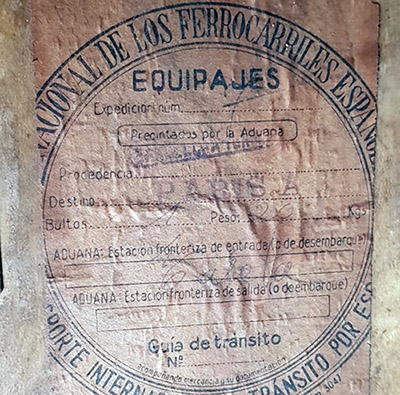
Baggage label from Red Nacional de los Ferrocarriles Españoles.
A trunk in our basement with a shipping label from the National Spanish Railway company suggests that Ronya probably eventually got her luggage back after her return to France. Although the name of the frontier station is not clear, the destination was Paris. As far as I know, she didn't return to Spain after the war, and the label looks old enough to match a mid- to late-40s time period. (The railway company was established in 1941.) If this was indeed the luggage she had left behind when boarding the "NYASSA", it confirms that Ronya hadn't come to Spain in 1943 empty-handed.
According to Michael Rosenberg, she didn't seem to be destitute:
"Ronya came with some savings, or maybe someone - maybe on the Mallah side - helped her with some money."
She lived in Talpiot, the modern neighborhood in Jerusalem, and stayed with the Galil family. (?)
Michael who lived in Jerusalem with his grandparents would see Ronya at least twice a week until the end of the war, or 46.
At the end of July 1946, Ronya left Jerusalem and moved back to Paris.
Paris
Back in Paris, Ronya returned to her apartment, 35, Rue de Lubeck. It is not clear how she had been able to hold on to the apartment while she was away for over three years. I presume she continued to pay the rent between April 1943 and July 1946.
A letter dated May 27, 1947 shows that she was looking into an eventual sale of SOCOM, the last venture of her husband Moritz. During the German occupation, the company had been administered by an "Aryan" Spanish citizen under the supervision of the Spanish Chamber of Commerce in Paris and the Spanish Consulate. This letter mentions a Mr. Costa, administrator for the company; and an accountant who didn't wish to handle the account anymore.
Around the same time, Ronya started a knitting business, possibly her first professional activity ever at the age for 56. She would run her business for over 10 years under the name "Ronia - Tricots de Luxe" ("Luxury Knitwear").
In 1954 and 1955 she travelled to Portugal and hired a lawyer to "defend my legitimate interests and rights, namely those related to the payment of coupons and the value of the loan from the Lisbon City Council (Loan at 4% of 1886)."
In June 1958 she held a "Carte de Légitimation pour Voyageurs de Commerce" (traveling salesman card), valid for England, Germany, Belgium, Switzerland, Spain, and Portugal. Her passport shows that she travelled for business to England, Belgium and Holland between June and August 1958 and was authorized to export there.
Her 1960 passport issued by the Spanish Consulate in Paris was "valid for all countries - except for regions under Soviet influence". Less than a year later, in June 1961, she nevertheless travelled to the USSR, visiting Leningrad and Moscow.

Ronya - Photo Studio Harcourt, Paris
Ronya died on April 28th, 1969, at the age of 77, in her apartment, 3 square de la Dordogne, Paris 16eme.
- Special Thanks:
- Rina Offenbach, Director "Bintivy Ha'apla" - Illegal Immigrant Database and Information Center, Atlit Detention Camp - SPIHS: Society for Preservation of Israel Heritage Sites, for information on the SS Nyassa.
- Pavel Goldin, for translating Ronya's 1909 Gymnasium report.
- Alain De Tolédo, Director of Muestros Dezaparesidos, for providing much information about the action of Bernardo Rolland and answering my questions about the situation of Spanish Jews who found refuge in Spain during the war. (2025)
- Cenker Sarıkaya, for sharing documents about Ronya in Constantinople.
- Interviews:
- Bitia Biesel
- Michael Rosenberg
- Alex Neuhoff
- References
- Aaron Aaronsohn Diaries
- The Riga Rabbinate Vital Records
- El Cónsul General Bernardo Rolland de Miota, y los Sefardíes de París (1939-1943), Matilde Morcillo. Ed: Riopiedras Ediciones, 2016.
- Mémorial des Judéo-Espagnols déportés de France, Ed: Muestros Dezaparesidos, 2019


